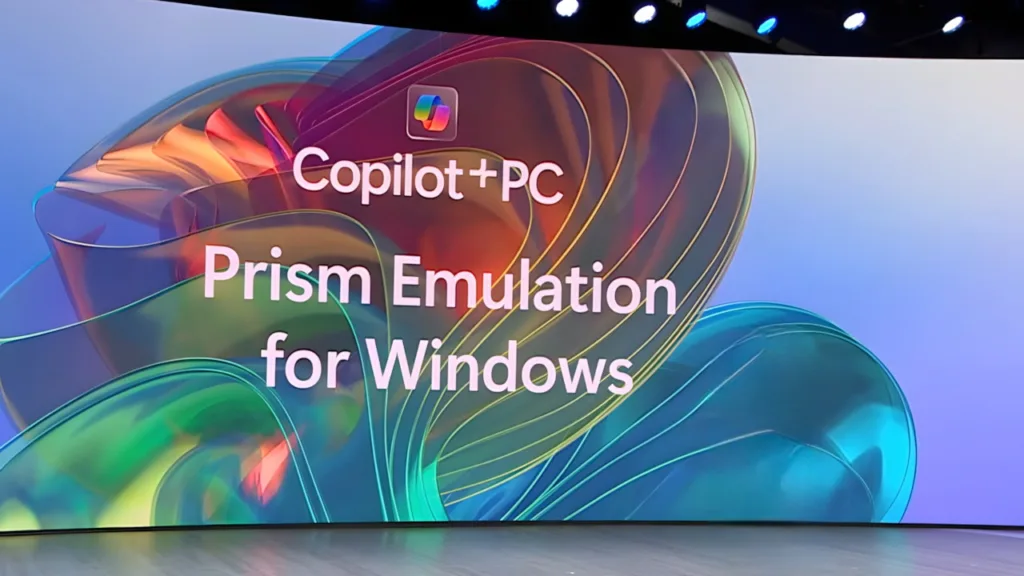
During the Surface Event 2024, Microsoft unveiled Copilot+ PCs, featuring the latest Surface Laptop 7th Edition and Surface Pro 11th Edition, equipped with ARM-based Snapdragon X series processors. At the event, Microsoft also introduced Prism, a cutting-edge emulation layer designed to enable x86-64 applications to run at nearly native speeds on ARM hardware.

The Prism layer is set to make its first appearance alongside Windows 11 24H2 for the Windows on ARM (WoA) platform. According to Microsoft, this new Prism layer matches the efficiency of Apple’s Rosetta 2, boasting a 2x acceleration in single-core tasks and a 3x enhancement in multi-core workloads when operating under emulation mode.
In this article, we examine Microsoft’s latest approach with its compatibility layer and explore whether there’s cause for concern when it comes to running x64 apps on Copilot+ PCs.
Demystified: Prism Emulation Layer for Windows on ARM
During the MS Build 2024 conference, Microsoft delved into the innovative Prism emulation layer, shedding light on its functionality. Microsoft highlighted their collaboration with ARM to revamp the Windows compiler, harnessing the benefits of Armv8 instruction set enhancements.
Beyond software enhancements, the ARM-based Snapdragon X series processors boast hardware advancements designed to execute x64 applications efficiently within the new emulation mode. Jon Masters, a computer architect specializing in ARM servers at Google, additionally unveiled the array of beneficial features offered by Armv8+ hardware for seamless on-the-fly binary translation.
In addition, Microsoft has undertaken the task of rebuilding numerous Windows components and Runtimes to enhance CPU performance when running applications within the Prism emulation layer. Furthermore, system binaries are now compiled utilizing ‘profile-guided optimizations,’ a method aimed at refining the performance of emulated applications by optimizing them based on data gleaned from their real-world execution.
Consequently, there’s been a remarkable 2x performance leap with Prism emulation, surpassing previous endeavors with the Microsoft SQ3 processor. Microsoft anticipates users will allocate up to 90% of their application time to native ARM software. Collaborating closely with developers, the company is actively facilitating the transition of native applications to the Windows on ARM (WoA) platform.

From Microsoft’s own applications to social media, entertainment, creativity, security, and development tools, nearly all major software categories now provide ARM-native versions for Windows 11. You can access a comprehensive list of native Windows ARM software from this link.
Gaming on Windows with the Prism Emulation Layer
Regarding gaming, the Prism layer demonstrates impressive capabilities. It seamlessly translates x64 binaries into ARM64 instructions in real-time. Moreover, it effectively translates drivers for the Adreno GPU and Windows libraries during emulation. Remarkably, both translated drivers and Windows libraries operate at nearly native speed, showcasing its exceptional performance.

During a demonstration, Microsoft showcased Baldur’s Gate 3 running in emulation mode, achieving a framerate of approximately 25 to 35 FPS. In another instance, Borderlands 3, also operating under emulation, surpassed 35 FPS, especially with Auto Super Resolution enabled.
Although these demonstrations are impressive, it’s important to await further testing to gauge the performance of the Prism emulation layer with additional titles. Additionally, Microsoft sponsors a website that curates a list of games compatible with Snapdragon X series processors, so be sure to explore it for more information.
Performance of Prism Emulation on Surface Laptop 7th Generation
Although Microsoft and other OEMs haven’t released their Copilot+ PCs, Microsoft has commissioned a report from Signal65 to assess the emulation performance of the Surface Laptop 7th Edition, equipped with Snapdragon X Elite.

According to the report, when Adobe Lightroom Classic runs under emulation on the new Surface Laptop with SD X Elite, it outperforms Intel’s 12th-gen Core i7 processor, which runs the application natively, by 30%. This finding is quite remarkable and indicates comparable performance to the Intel Core Ultra 7 155H when operating under emulation.
During the Blender test, the SD X Elite-powered Surface Laptop 7th Edition demonstrates a 35% increase in performance while operating in emulation mode. However, it’s important to note that the Intel Core Ultra 7 155H and Apple’s MacBook Air M3 outperform it in this scenario. Nevertheless, it’s worth considering that they are running the native version of the application.
The report concludes with the following statement:
Emulated performance on the new device is outperforming even the native performance of the 12th Gen Core i7 previous generation Surface Laptop 5 – an impressive feat that should settle the nerves of any consumer debating the purchase of a new PC using this processor.
It appears that the new Prism emulation layer is indeed quite robust, indicating that running x64 applications on the next-generation Copilot+ PCs shouldn’t pose significant challenges. Moreover, developers are increasingly adapting their applications for native ARM64 architecture, promising even better performance and efficiency in the future.

 (@jonmasters)
(@jonmasters) 


